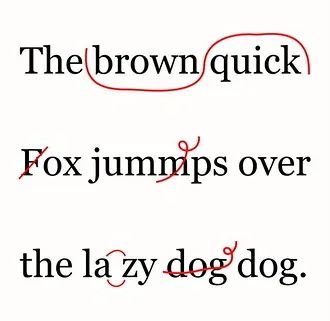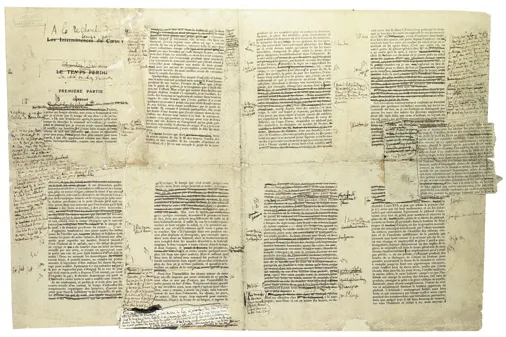
An Editing and Proofreading Glossary
If you want to become a proofreader, it helps to know the lingo. And as with any industry, editing and proofreading has its own terminology. Check out the glossary below to learn a few key terms that you would need to know to become a proofreader or editor.
Copy Editing
Copy editing typically involves refining a document in three ways:
- Removing errors and inconsistencies
- Improving readability
- Ensuring it is suitable for its audience and purpose
Some people also distinguish between copy editing (removing errors and inconsistencies) and line editing (editing for style and phrasing). However, both occur toward the end of the editing process and both are about refining a text rather than making substantive changes.
Developmental Editing
Developmental editing involves helping an author to develop a manuscript. A developmental editor may be involved from the start of a project, offering guidance on the concept, content and structure of a text, then coaching them through the writing process chapter by chapter.
However, a publisher may also ask for developmental editing after the author has written a first draft, especially if the manuscript requires significant revision or restructuring.
Editing
Editing is a very broad term, covering everything from helping to develop a manuscript (developmental editing) to correcting errors in a final draft before typesetting (copy editing).
In the publishing world, an acquisitions editor is responsible for acquiring manuscripts for a publishing house and overseeing the editing process. Sometimes they help to edit or develop the manuscript as well, but they may also delegate this work to another editor.
Hard-Copy Editing
Hard-copy editing involves editing a document on paper (i.e., hard copy). This is rarer than it used to be, but it still plays an important role in the publishing industry. Some traditionalist clients also prefer to have their work edited on hard copy.
Manuscript
The manuscript is the document that an author submits to a publisher or editor.
Marking Up
To mark up a document is to annotate it with suggested corrections or changes. There are many ways to mark up a document, but two of the most common are:
- Using traditional proofreading marks to annotate hard copy or a PDF
- Using a redlining tool like Microsoft Word’s Track Changes when editing on-screen
In either case, it is important to mark up errors clearly and consistently when proofreading.

Example proofreading marks.
(Image: volkspider/flickr)
Mechanical Editing
Mechanical editing is any kind of editing that focuses on:
- Correcting spelling, grammar, and punctuation errors
- Fixing issues to do with clarity or consistency
- Applying a given style sheet or guide to a document
- Ensuring the language in a document is suitable
It does not, however, involve making major changes to the content or structure of a document.
On-Screen Editing
On-screen editing involves editing a document on a computer, usually in a word processor.
Proofreading
Traditionally, proofreading was the final stage of editing. The idea was to check a proof (i.e., a test version of a document made before publication) for errors missed during prior editing or introduced during typesetting. This is still how proofreading works in the publishing world.
Modern on-screen editing makes it easier to combine proofreading and copy editing. This is common when working on documents that aren’t intended for publication.
Proofs (Page Proofs, Revised Proofs, Final Proofs)
A proof is a test version of a publication produced before mass printing. Traditionally, this is what a proofreader checks for errors after a manuscript has been typeset. Proof types include:
- Page proofs (i.e., the initial typeset version of a publication)
- Revised proofs (i.e., a set of proofs incorporating any changes from the first proofread)
- Final proofs (i.e., the final version approved for printing by the publisher and author)
The term galley proof, meanwhile, comes from the “galleys” used to set type for printing.

Annotated galley proofs.
Query
A query is a question left by an editor or proofreader for the author. Sometimes, an author will also leave a query to ask about a change to a manuscript after editing or proofreading.
Style Guide
A style guide is a published set of standards for writing. Depending on the guide, this can include advice on writing style, formatting, document design, and referencing sources.
Style guides come in many types, including:
- Regional style guides that focus on a specific dialect (e.g., A Dictionary of Modern English Usage, which offers advice on using British English)
- Academic style guides, which focus on student writing and academic publishing (e.g.,The Chicago Manual of Style or The Modern Language Association Handbook)
- Journalistic style guides, which offer writing advice for journalists (e.g., the AP Stylebook)
Editors and proofreaders will often need to follow a style guide when working on a document.
Style Sheet
A style sheet is a list of stylistic preferences used by an author or institution. When an organization has a style sheet or guide, it will set out the house style for their written material.
As an editor or proofreader, you may need to create a style sheet for some projects. This is especially useful if working on a long document or multiple documents for a regular client.
Substantive Editing
Substantive editing focuses on “big picture” issues regarding a document, such as its structure and content. This could include helping an author to develop or rewrite a manuscript.
Typesetting
Typesetting involves preparing the text and images from a manuscript for printing. This used to be done with moveable type, but it now typically involves arranging digital type on-screen.
Becoming a Proofreader
We hope you’ve found this list of proofreading terms helpful. To learn more about proofreading and editing, you can take one of Proofreading Academy’s courses.
As well as terminology, we offer guidance on common errors, editing techniques, different writing styles, and how to use Microsoft Word effectively. Sign up for a free trial today.



Join the Conversation
Leave a Comment
Your email address will not be published.